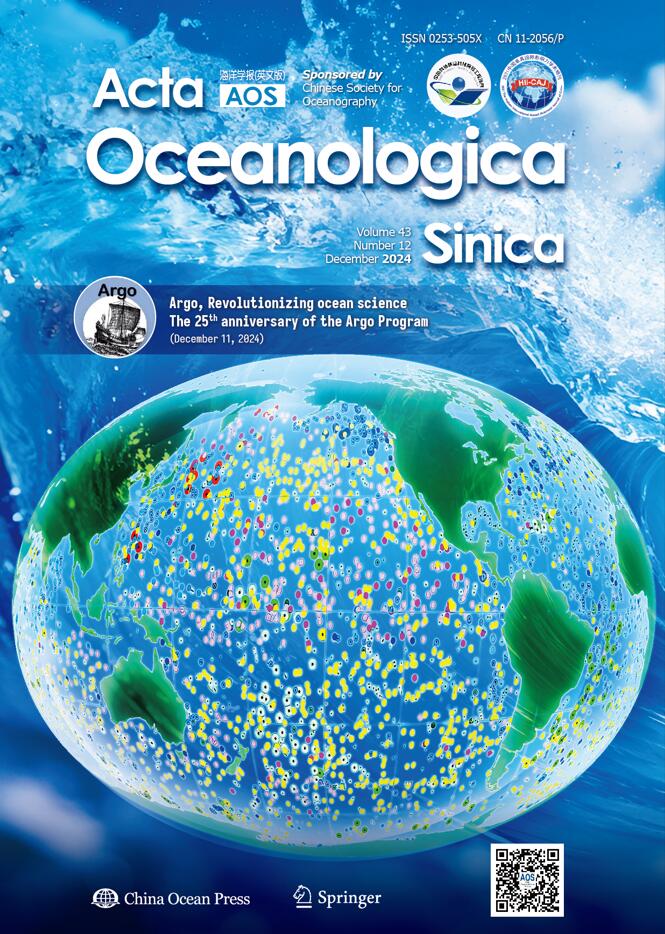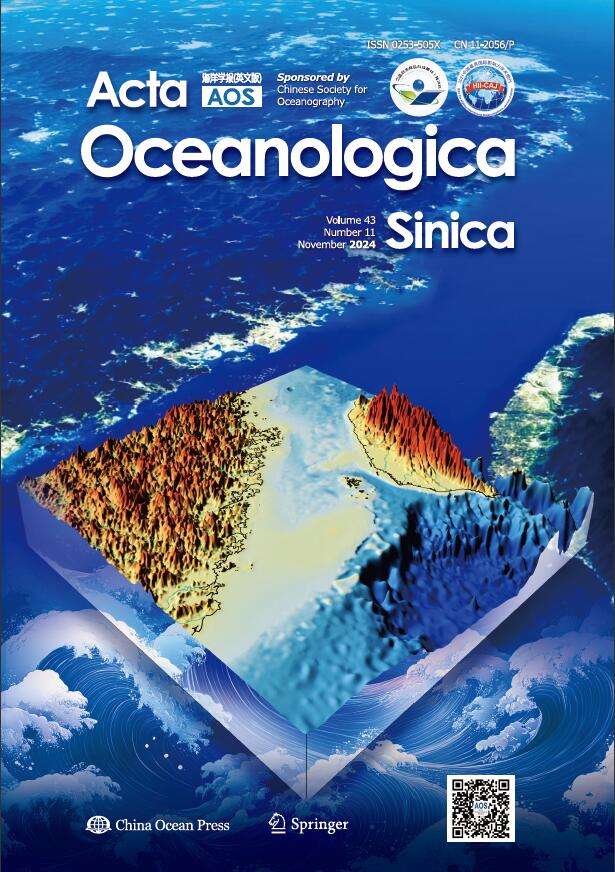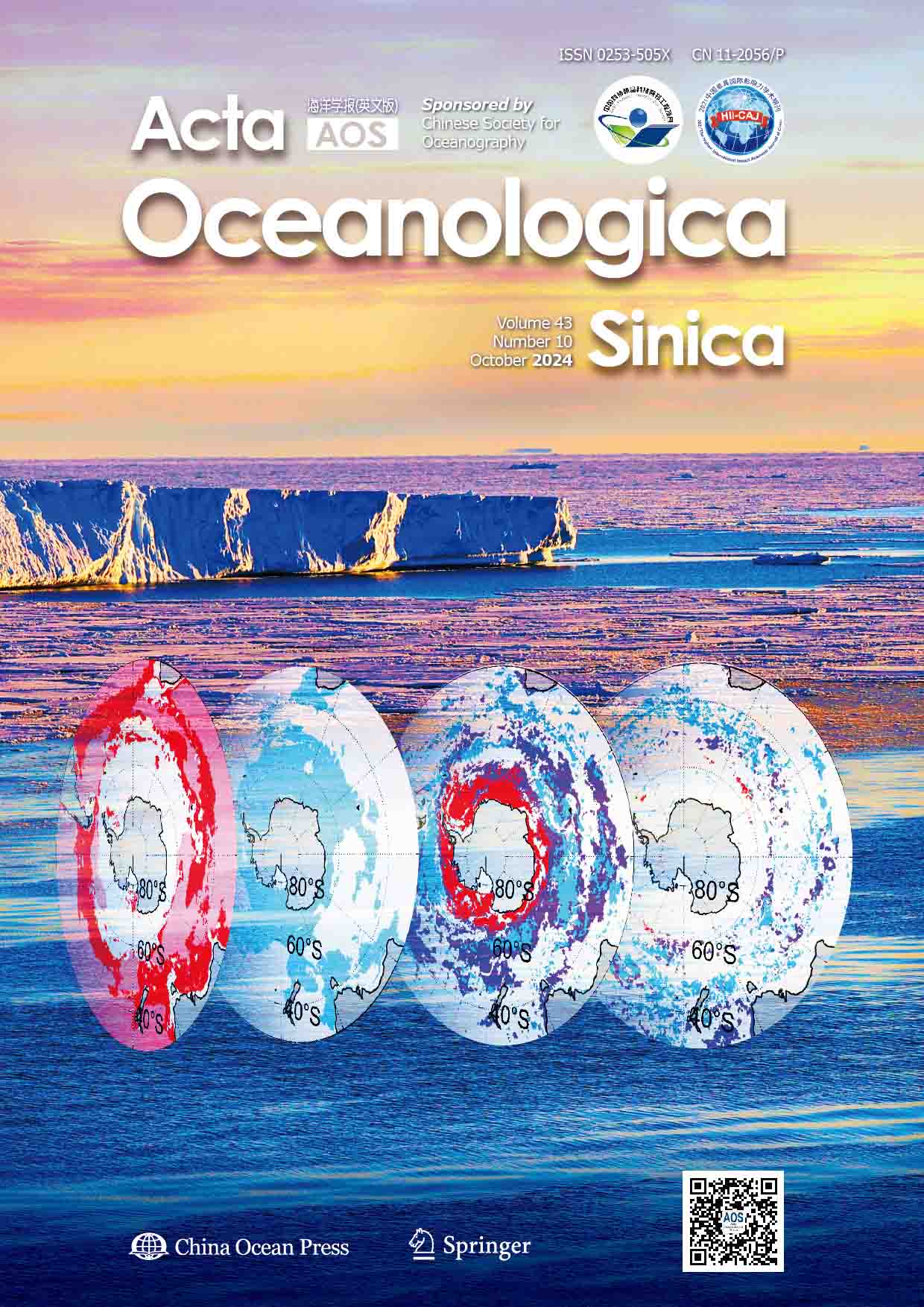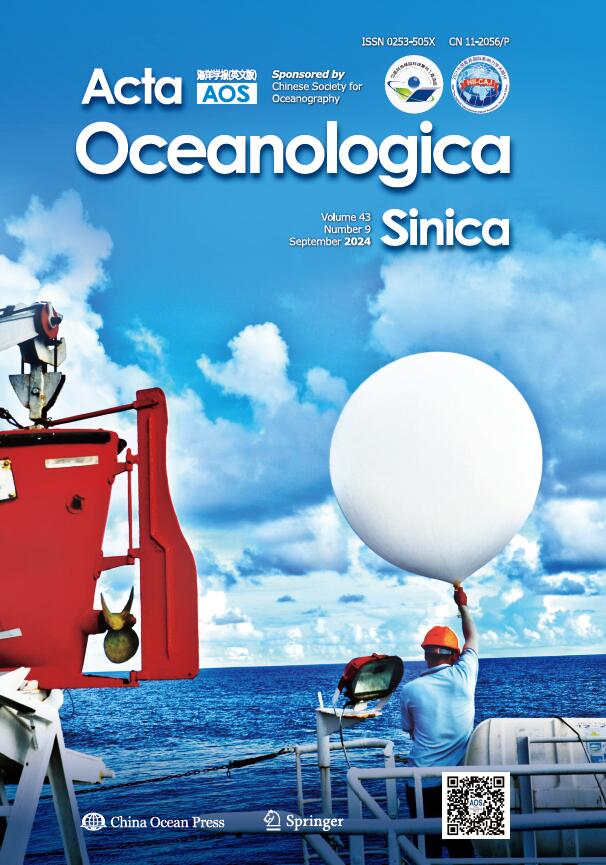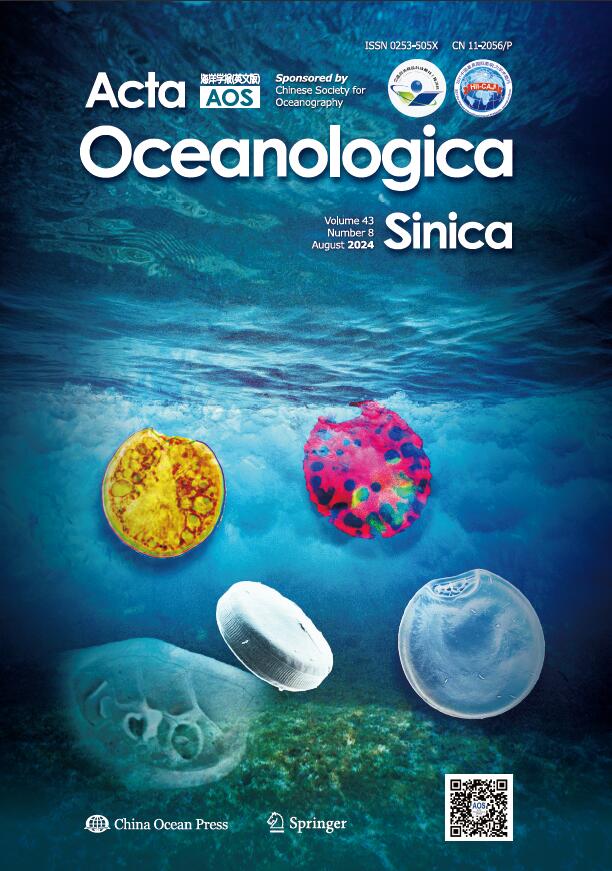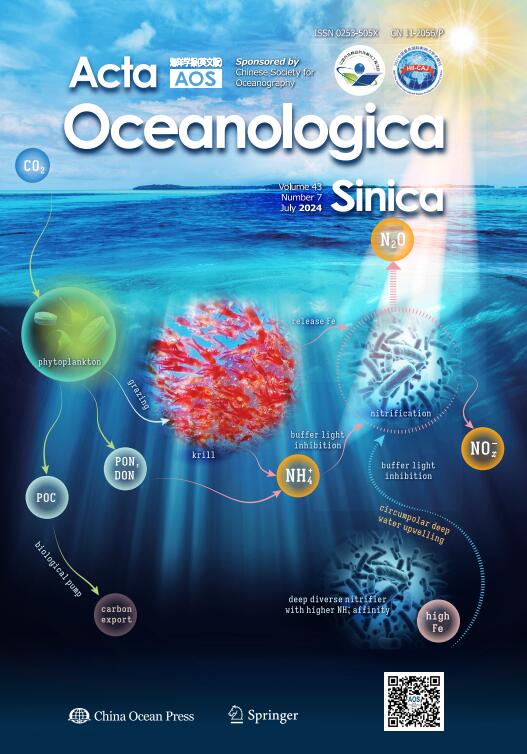2023 Vol. 42, No. 3
Display Method:
2023, 42(3): 1-18.
doi: 10.1007/s13131-022-2082-5
Abstract:
The geochemical signatures of fifty-four rock samples and three supplementary drill stem test (DST) oils from the Yacheng-Sanya formations in the central Qiongdongnan Basin (CQB) were analysed. Reconstruction of the early Oligocene−early Miocene (36–...
The geochemical signatures of fifty-four rock samples and three supplementary drill stem test (DST) oils from the Yacheng-Sanya formations in the central Qiongdongnan Basin (CQB) were analysed. Reconstruction of the early Oligocene−early Miocene (36–...
2023, 42(3): 19-30.
doi: 10.1007/s13131-022-2078-1
Abstract:
Studies in the northern South China Sea (SCS) basement remain important for understanding the evolution of the Southeast Asian continental margin. Due to a thick cover of sediments and scarce borehole penetration, little is known about the age and te...
Studies in the northern South China Sea (SCS) basement remain important for understanding the evolution of the Southeast Asian continental margin. Due to a thick cover of sediments and scarce borehole penetration, little is known about the age and te...
2023, 42(3): 31-53.
doi: 10.1007/s13131-022-2081-6
Abstract:
The increase of total organic carbon content of the late Oligocene−early Miocene terrigenously-dominated marine shales in the shallower depth intervals was reported in the Ying-Qiong Basin, South China Sea. The organic enriched lower Sanya Formation ...
The increase of total organic carbon content of the late Oligocene−early Miocene terrigenously-dominated marine shales in the shallower depth intervals was reported in the Ying-Qiong Basin, South China Sea. The organic enriched lower Sanya Formation ...
2023, 42(3): 54-64.
doi: 10.1007/s13131-022-2080-7
Abstract:
The sedimentary system of Kalimantan has undergone significant development since the Oligocene. Previous research have largely ignored the capacity of the Cretaceous–Eocene sediments to produce hydrocarbons, focusing instead primarily on the Oligocen...
The sedimentary system of Kalimantan has undergone significant development since the Oligocene. Previous research have largely ignored the capacity of the Cretaceous–Eocene sediments to produce hydrocarbons, focusing instead primarily on the Oligocen...
2023, 42(3): 65-75.
doi: 10.1007/s13131-022-2079-0
Abstract:
Carbonate cements are the most abundant authigenic mineral and impact on physical properties greatly in sandstone reservoir. In this paper, Pinghu Formation of Xihu Sag was taken as a target. Characteristics, distribution and formation of carbonate c...
Carbonate cements are the most abundant authigenic mineral and impact on physical properties greatly in sandstone reservoir. In this paper, Pinghu Formation of Xihu Sag was taken as a target. Characteristics, distribution and formation of carbonate c...
2023, 42(3): 76-88.
doi: 10.1007/s13131-022-2128-8
Abstract:
The hydrocarbon gases in the L1 gas field of the Lishui-Jiaojiang Sag have been commonly interpreted to be an accumulation of pure sapropelic-type thermogenic gas. In this study, chemical components, stable isotopic compositions, and light hydrocarbo...
The hydrocarbon gases in the L1 gas field of the Lishui-Jiaojiang Sag have been commonly interpreted to be an accumulation of pure sapropelic-type thermogenic gas. In this study, chemical components, stable isotopic compositions, and light hydrocarbo...
2023, 42(3): 89-100.
doi: 10.1007/s13131-022-2127-9
Abstract:
Both Pinghu and Huagang formations are important hydrocarbon reservoirs of the Xihu Depression in the East China Sea Shelf Basin. Clarifying the source suppliers and restoring source-to-sink transport routes are of great significance to the future pe...
Both Pinghu and Huagang formations are important hydrocarbon reservoirs of the Xihu Depression in the East China Sea Shelf Basin. Clarifying the source suppliers and restoring source-to-sink transport routes are of great significance to the future pe...
2023, 42(3): 101-112.
doi: 10.1007/s13131-022-2134-x
Abstract:
Sea area is an important area of oil and gas exploration in China. It has been found that China’s sea area mainly consists of coal type oil and gas, and the exploration of coal-bearing series source rocks has become an important part of oil and gas e...
Sea area is an important area of oil and gas exploration in China. It has been found that China’s sea area mainly consists of coal type oil and gas, and the exploration of coal-bearing series source rocks has become an important part of oil and gas e...
2023, 42(3): 113-122.
doi: 10.1007/s13131-022-2133-y
Abstract:
The East China Sea Shelf Basin generated a series of back-arc basins with thick successions of marine- and terrestrial-facies sediments during Cenozoic. It is enriched with abundant oil and gas resources and is of great significance to the petroleum ...
The East China Sea Shelf Basin generated a series of back-arc basins with thick successions of marine- and terrestrial-facies sediments during Cenozoic. It is enriched with abundant oil and gas resources and is of great significance to the petroleum ...
2023, 42(3): 123-137.
doi: 10.1007/s13131-022-2132-z
Abstract:
This study involved outcrop, drilling, seismic, gravity, and magnetic data to systematically document the geological records of the subduction process of Proto-South China Sea (PSCS) and establish its evolution model. The results indicate that a seri...
This study involved outcrop, drilling, seismic, gravity, and magnetic data to systematically document the geological records of the subduction process of Proto-South China Sea (PSCS) and establish its evolution model. The results indicate that a seri...
2023, 42(3): 138-150.
doi: 10.1007/s13131-022-2141-y
Abstract:
The terrigenously-dominated marine shales which were deposited in the lower Eocene Pinghu Formation were thought to be a potential source rock in the Xihu Depression of the East China Sea Shelf Basin. However, the exceptionally high total organic car...
The terrigenously-dominated marine shales which were deposited in the lower Eocene Pinghu Formation were thought to be a potential source rock in the Xihu Depression of the East China Sea Shelf Basin. However, the exceptionally high total organic car...
2023, 42(3): 151-166.
doi: 10.1007/s13131-022-2142-x
Abstract:
Dissolution mechanism and favorable reservoir distribution prediction are the key problems restricting oil and gas exploration in deep-buried layers. In this paper, the Enping Formation and Zhuhai Formation in Baiyun Sag of South China Sea was taken ...
Dissolution mechanism and favorable reservoir distribution prediction are the key problems restricting oil and gas exploration in deep-buried layers. In this paper, the Enping Formation and Zhuhai Formation in Baiyun Sag of South China Sea was taken ...
2023, 42(3): 167-188.
doi: 10.1007/s13131-022-2136-8
Abstract:
Owing to the strategic significance of national oil and gas resources, their exploration and production must be prioritized in China. Oil and gas resources are closely related to deep crustal structures, and Moho characteristics influence oil and gas...
Owing to the strategic significance of national oil and gas resources, their exploration and production must be prioritized in China. Oil and gas resources are closely related to deep crustal structures, and Moho characteristics influence oil and gas...
2023, 42(3): 189-200.
doi: 10.1007/s13131-022-2140-z
Abstract:
The eastern main sub-sag (E-MSS) of the Baiyun Sag was the main zone for gas exploration in the deep-water area of the Zhujiang River (Pearl River) Mouth Basin at its early exploration stage, but the main goal of searching gas in this area was broken...
The eastern main sub-sag (E-MSS) of the Baiyun Sag was the main zone for gas exploration in the deep-water area of the Zhujiang River (Pearl River) Mouth Basin at its early exploration stage, but the main goal of searching gas in this area was broken...
2023, 42(3): 201-214.
doi: 10.1007/s13131-022-2139-5
Abstract:
The China seas and adjacent areas contain numerous petroleum basins. One of the main challenges for future oil and gas exploration is to identify the inherent patterns of petroleum basin distribution. The formation and evolution of petroleum basins a...
The China seas and adjacent areas contain numerous petroleum basins. One of the main challenges for future oil and gas exploration is to identify the inherent patterns of petroleum basin distribution. The formation and evolution of petroleum basins a...
2023, 42(3): 215-226.
doi: 10.1007/s13131-023-2148-z
Abstract:
There are many large-scale Cenozoic sedimentary basins with plentiful river deltas, deep-water fans and carbonate platforms in the southern South China Sea. The Crocker Fan was deposited as a typical submarine fan during the late Eocene–early Miocene...
There are many large-scale Cenozoic sedimentary basins with plentiful river deltas, deep-water fans and carbonate platforms in the southern South China Sea. The Crocker Fan was deposited as a typical submarine fan during the late Eocene–early Miocene...
2023, 42(3): 227-242.
doi: 10.1007/s13131-022-2138-6
Abstract:
As one of the main controlling factors of oil and gas accumulation, faults are closely related to the distribution of oil and gas reservoirs. Studying how faults control petroliferous basins is particularly important. In this work, we investigated th...
As one of the main controlling factors of oil and gas accumulation, faults are closely related to the distribution of oil and gas reservoirs. Studying how faults control petroliferous basins is particularly important. In this work, we investigated th...
2023, 42(3): 243-253.
doi: 10.1007/s13131-023-2177-7
Abstract:
The discovery of the Bozhong 19-6 gas field, the largest integrated condensate gas field in the eastern China in 2018, opened up a new field for the natural gas exploration deep strata in the Bohai Bay Basin, demonstrating there is a great potential ...
The discovery of the Bozhong 19-6 gas field, the largest integrated condensate gas field in the eastern China in 2018, opened up a new field for the natural gas exploration deep strata in the Bohai Bay Basin, demonstrating there is a great potential ...
2023, 42(3): 254-269.
doi: 10.1007/s13131-023-2176-8
Abstract:
The Xihu Depression in the East China Sea Shelf Basin is a large petroliferous sedimentary depression, in which oil and gas reservoirs were mainly discovered in the Pinghu Slope and the central inversion zone. The oil-gas source correlation in the Xi...
The Xihu Depression in the East China Sea Shelf Basin is a large petroliferous sedimentary depression, in which oil and gas reservoirs were mainly discovered in the Pinghu Slope and the central inversion zone. The oil-gas source correlation in the Xi...



